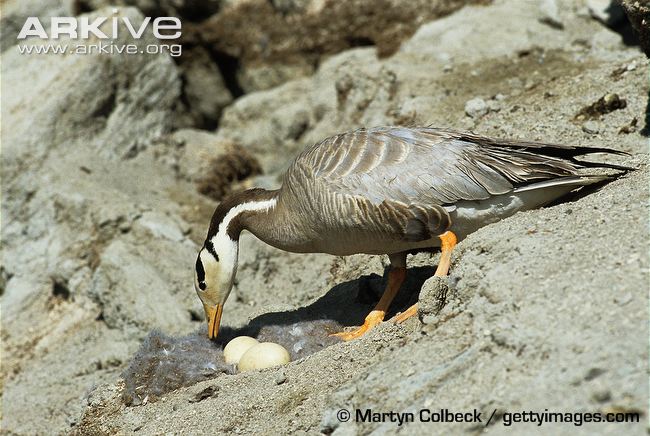Interactions
 The bar-headed goose’s diet changes seasonally. It is
consistently a primary —herbivorous—consumer, although it will
occasionally feed on small insects and snails. From January
through February, it primarily feeds on grasses until seeds
become a staple of its diet in March. Then it feeds on field
crops, such as wheat, as they become in season (Middleton and
Van Der Valk, 1987). The bar-headed goose also often feeds on
rice (Tampa's Lowry Park Zoo, 2014). Crop foraging is only a minor interaction
with humans compared to the goose’s ability to spread bird flu
viruses.
The bar-headed goose’s diet changes seasonally. It is
consistently a primary —herbivorous—consumer, although it will
occasionally feed on small insects and snails. From January
through February, it primarily feeds on grasses until seeds
become a staple of its diet in March. Then it feeds on field
crops, such as wheat, as they become in season (Middleton and
Van Der Valk, 1987). The bar-headed goose also often feeds on
rice (Tampa's Lowry Park Zoo, 2014). Crop foraging is only a minor interaction
with humans compared to the goose’s ability to spread bird flu
viruses.
The bar-headed goose has been the subject of major studies as
to how its migration pattern influences the outbreak of the bird
flu, such as H5N1. As a host to this virus, there is a high
correlation between outbreak origin and one of the largest of
the bird’s nesting sites, Qinghai Lake, in China. In Mongolia,
outbreak of this influenza occurred within months of migration
through the country. Similarly, the bar-headed goose’s entire
route, spanning from Myanmar through China to Mongolia, exhibits
the devastating repercussions of the bird’s role in influenza
virus spread and outbreak (Prosser et al., 2009). The extent of
wild birds’ role in spreading H5N1 is not fully known; evidence
from studies tracking the bar-headed goose and the ruddy
shelduck (Tadorna Ferruginea) provided strong evidence toward
their role as major carriers (Prosser et al., 2009).
One of the most unique of the bar-headed goose’s interactions
takes place within its own species. In the first two years of
age, many female geese will become “parasites” to nesting
females by laying their eggs in various nests when they lack a
nest of their own (Weighmann and Lamprecht, 1991). This behavior
ultimately decreases the investment nesting females can give to
their own offspring as well as the parasite’s. According to a
study performed with semi-captive geese, only about 5-6% of
parasitic eggs hatch successfully, and the number of
non-parasitic eggs to hatch successfully decreased from 67% to
29% in parasitized nests. Nonetheless, the intriguing existence
of intraspecies “parasites” could be highly adaptive, as more
birds can reproduce without having access to nests during
difficult conditions, increasing genetic variation. Then, in
good conditions, all birds are capable of nesting and
reproducing very effectively (Weighmann
and Lamprecht, 1991).
Interestingly, the bar-headed goose isn't the only bird with
this behavioral adaptation. Another bird that exhibits similar
nest parasitism is the
tree swallow (Whittingham and Dunn, 2001).
Has this caught your attention? Check out these
Interesting Facts.
...Or go
Home.